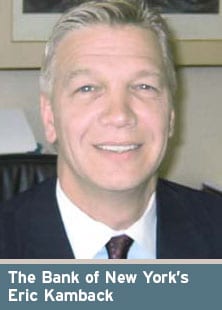At a recent meeting in London Global Finance brought together a group of experts on the treasury and cash management business to discuss current trends in the industry. Joseph Giarraputo moderated.
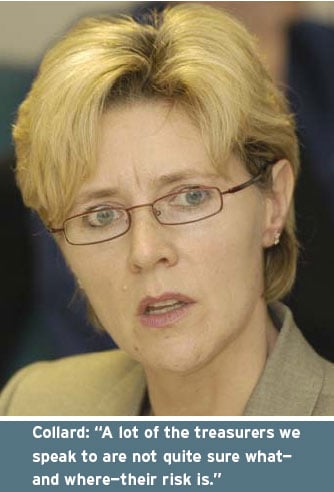
GLOBAL FINANCE:
What should company treasurers be concerned about in the current regulatory environment?
ERIC BREWER, executive director, cash flow advisory, working capital group and EMEA regional sales manager, ABN AMRO: Its an extremely dynamic environment. We partner with them to stay on top of these issues, such as the Patriot Act and Basel II, and then work with them to address it from a treasury standpoint.
KEN LILLIE, principal business consultant, Sungard Treasury Services: They have to be very careful that the figures theyre reporting are correct.The treasurer needs to be able to report with confidence on his figures so we try to help the treasurer provide a sound financial document.
NICK DIAMOND,
senior vice president, regional sales manager, global treasury management sales, Europe, Middle East & Africa, Bank of America: Clients need to question and understand the controls and processes theyve established for managing treasury activity, whether for making payments, receiving information or designating signatories and authority.
ANNE COLLARD,
vice president, head of EMEA treasury services consulting group, JPMorgan Chase:Were being asked how we can help them ensure transparency and visibility of data. If youre a regional or global treasurer, youre being asked to sign off on Honduras or Singapore, and you really want to understand whats going on.The banks can help.
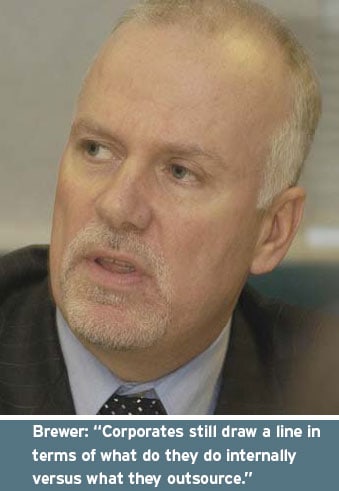
STEVE CANNING,
country manager, UK, XRT Software: Theyre questioning the quality of the data theyre getting, even from places like Spain.They expect a Sarbanes-Oxley equivalent to come in other regions, and they want to be ready.
THOMAS BERGQVIST,
executive vice president, general manager, Northern Europe, Trema:We are really going back to basics. We are talking about consistency of and access to data. Its not advanced risk management; its basic functionality.You really have to set up the right infrastructure and standardize the processes globally.
DIAMOND:
The new emphasis on Know Your Customer [KYC] and antimoney- laundering has significantly changed the way banks manage documentation requirements.We need to work with clients on this issue and manage their expectations.
STEPHAN M. SCHROETER,
managing director, EMEA sector head, consumer and health care, Citigroup Global Transaction Services: Its adding additional costs, and European clients in particular are not really willing to pay for that yet. But its an opportunity to build partnerships with clients and to get closer to clients.
BREWER:
Were seeing caution in terms of how far banks step over the line by providing tax and legal advice, and what is the legal liability between the financial institution and the corporate when you start stepping into consulting and advisory.
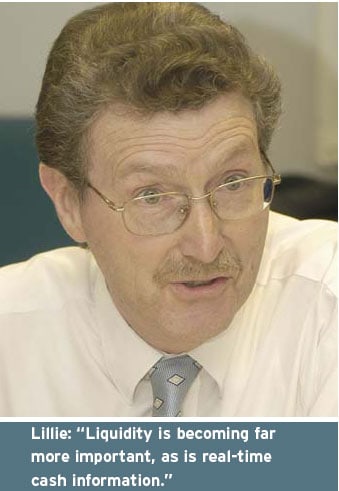
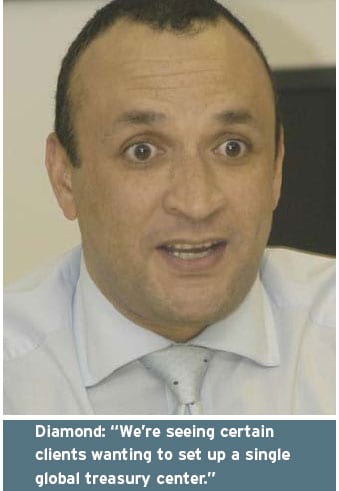
ANDREW R. ENGLAND,
managing director, global head of product management, Deutsche Bank: Additional controls are being put in place at both the corporates and some of their suppliersbanks being one of them.More clients are asking how were dealing with these additional controls while ensuring the client is not negatively impacted.
GF:
What should a corporate cash manager or treasurer be doing regarding continuing consolidation in the banking industry?
DIAMOND:
Further consolidation is inevitable. Clients ought to be looking at their overall relationship with their bank suppliers. If I were a client, Id want to be using a full set of products and services from my key relationship banks. If they were then acquired, Id still remain an important relationship with that bank.
COLLARD:
If you have two major providers suddenly merging, you could find credit lines dramatically reduced.The client needs to know what will happen. Even things like account numbers need to be considered. Do you merge account numbers? Or find a way of mapping them? You may have been totally integrated to one bank, and all of a sudden you find yourself not so with another. The key is openness and transparency of information.
SCHROETER:
All of our sophisticated clients review their bank relationships regularly.Theyre starting to look for nonbanking partners to replace some of the bank partners. Our biggest competition in terms of outsourcing as banks is the non-banking sector, partly because clients dont want to be exposed to risk through consolidation.
BERGQVIST:
Clients dont really get the benefits from mergers, so the big corporates are working to a bank-independent strategy. Thats why we see much more in-house banking.
BREWER:
Corporates need to be proactive and not wait until a merger is announced. They should bring it up in annual relationship reviews and set down what the expectations are if and when this event does occur. Second, they should be proactive in assessing the resource utilization that would be required from the corporate for any merger that occurs within the treasury area.
LILLIE:
The major systems providers are finding their relationship with clients is more partnership than just applying software. Because of that we are acting in partnership with the banks as well.Between us we can deliver a complete solution.
GF:
What particular risks should corporates be aware of today? And what are your organizations doing to help corporates deal with these risks?
CANNING:
I dont see enough corporate treasurers taking risk seriously. Many just dont seem to understand the subject.
LILLIE:
Treasurers may be managing the risk, but they probably havent defined it properly. If you havent defined and quantified that risk before you start to manage it, you can make a terrible mess.The most important thing is to help the corporate define and measure risks; then help them analyze how theyre managing the risks and look for improvements.
CANNING:
The great problem is finding information with which they can actually assess whether theyre managing their risk properly.
SCHROETER:
Thats an opportunity for us, to go in and advise our clients on how they should do it.Thats our jobnot just banks but technology providers as well.
COLLARD:
A lot of the treasurers we speak to are not quite sure whatand wheretheir risk is. The interesting thing is to try to help them identify where those risks are and, perhaps, how we can take on the management of some of those things to help them with operating and systemic risk.
BREWER:
The nature of risk is changing. Were getting a lot of questions on business continuity, disaster recovery, personal security risk for employeesits a whole new ballpark.
ENGLAND:
The whole focus on operational risk is significantly more developed than it was a few years ago.To help corporates understand better how the bank will address that risk, you need to put the operations managers and maybe product people right in front of them.
GF:
Outsourcing of treasury functions has been of great interest to banks for several years, but their customers have been less interested in the concept. Is this changing?
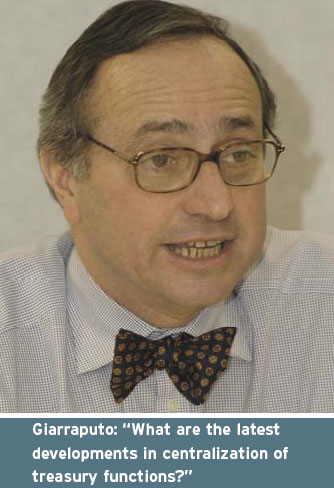
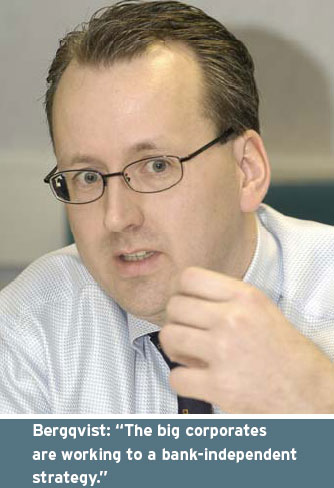
BREWER:
Youll continue to see outsourcing from high-cost to lower-cost regions, and youll see it moving up the food chain in terms of the services that are provided. Corporates will still draw a line in terms of what do they do internally versus what they outsource, as will the banks on what they will be willing to take on from a cost perspective.We see private labeling cooling off.
DIAMOND:
Outsourcing is becoming a more frequent occurrence. Previously, running the FX book or short term investment book was considered a core treasury function and would not have been considered for outsourcing. Im not sure it is anymore.
SCHROETER:
As the scope gets broader, theres a fundamental question whether banks can find a business model to actually make outsourcing work commercially.
LILLIE:
The concept is great, but its difficult to make it profitable.What seems to be attractive is uploading a whole load of repetitive transactions.
COLLARD:
The marketplace is moving toward standardization, where youre offering a solution that can run utility infrastructures and manage services as opposed to outsourcing control. The model is changing, and were seeing a huge pickup.
SCHROETER:
The question is, Can a bank really create a standard that works for everybody? And are clients really willing to do that? Being dependent on a single bank is not what the sophisticated treasurer wants these days.
LILLIE:
Treasurers are not only trying to add value themselves; they want their suppliers to help them add value.When they outsource, they need to see where theyre getting value back.
BERGQVIST:
The banks have to get further down in their clients business and understand their business more, to be less product focused.
BREWER:
Were starting to align within our wholesale and corporate investment banking more from an industry perspective, to develop the product offerings and deliver them specifically from an industry standpoint instead of a standpoint of build it and they will come, one size fits all.
ENGLAND:
We dont have that standardization yet, and its not really going to move until the banks can get to a service level that meets core expectations for treasuries.
GF:
Centralization of treasury functions seems to be currently in vogue.What are the latest developments in this area?
DIAMOND:
Were seeing certain clients wanting to set up a single global treasury center as opposed to treasury centers located in each region.
LILLIE:
The technology exists to make that happen. The treasurers are now working with banks and their systems advisers to put it into place.
CANNING:
A survey last year showed over 60% of major corporates in Europe did not have a treasury management system. Its that sort of thing thats driving centralization because the global treasurers have little idea of whats going on around the world.
BREWER:
The regional hubs are being used as microcosms for how to pull their systems together.
ENGLAND:
As the head office treasury function takes more interest in the regional ones, youre seeing a gradual extension into standardization of information. That is the precursor to making the global treasurer a viable and efficient option.
BERGQVIST:
Today, when you see clients go to market to get systems, they all go for a global solution.The banks are opening up their systems much better now so we can push all the accounting information and collect data from them.
COLLARD:
Centralization has been around for years.Weve all moved in that direction,but there will always be different degrees.There will be a next step forward.
BERGQVIST:
Some things you want centralized, some things you want decentralized its about having the right structure so you can do both.
LILLIE:
You can have a global implementation of a system so the information is available to everyone who you want it to be available to, around the world.
DIAMOND:
There arent many global treasury centers yet, but some of our clients have achieved this model and others are also close.We, as the suppliers, need to help them achieve this goal.
GF:
Global liquidity has become increasingly important.What are the latest developments in this area?
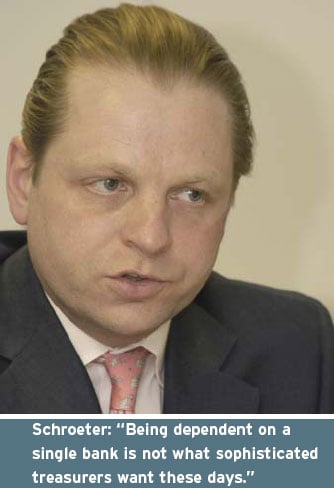
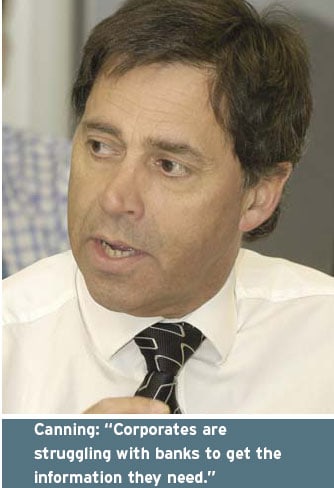
BREWER:
Were getting a tremendous interest in aggregating funds. Our corporates are pushing us to push the boundaries, cross-region and cross-country.
LILLIE:
Analysts and bankers are looking far more at a companys ability to declare their current cash position and their short-term forecasts for cash, so global liquidity is becoming more and more important.
SCHROETER:
It comes back to the risk management role of the treasurer. Global liquidity helps them manage the risks.
CANNING:
Corporates are struggling with banks to get the information they need in more remote parts of the world. When they want an intraday position, they cant get it.
COLLARD:
Global liquidity is really demand- driven; its been around for some time.We have clients today who are running global liquidity positions. The key thing, though, is that theyre mainly in the major currencies.You have to sometimes go with the 80-20 rule.You can get 80% of what you need within a reasonable cost base, and then you start to work on the 20%.
ENGLAND:
We have this continuous circle where the clients say they want this to happen, so the software houses and the banks make it happen.We are all moving forward together.
BERGQVIST:We are also pushing, but the biggest problem is cost of integration.Thats stopping you from getting the last 20%.
GF:
The CLS Bank now seems an attractive way for some large corporates to mitigate their foreign exchange settlement risk. If large corporates become third-party users of the CLS Bank, what impact would this have on banks and the corporates?
BREWER:
In the foreign exchange environment, adoption rates have been limited. For it to be a success, the majority of the counter parties have to participate, otherwise its just another clearing mechanism. When you look at CLS without including third-party payments, it becomes less interesting.
DIAMOND:
Were seeing some initial interest in CLS from the corporates.They perceive it as a way of managing their settlement risk and eliminating operational risk.
BERGQVIST:
Its not a big issue to integrate with CLSs, but theres not big client demand for it.
COLLARD:
This was supply-driven. A lot of corporates are not 100% aware of the benefits of becoming a third-party member.
ENGLAND:
Were a year down the road; theres been some success, but theres a long way to go. In the future there will be more meaningful discussions with corporates and what it can do for them.
GF:
What are the key issues relating to payment factories.

BREWER:
The payment routers, the translation utilities, the ability to get the information and aggregate it are absolutely key. Those that have them underestimated what it would take to get them up and running. Its a long trek.
CANNING:
The payment factories weve implemented have been extremely successful: The clients have seen huge reductions in the fees theyre paying to the banks.
BERGQVIST:
You need to keep in balance how aggressively you do it.You start from the treasury, you do the in-house banking part, and then you start moving into payment factories. Critically, you need to have the business units with you.
COLLARD:
If you can get both treasury and commercial payments running through this environment, and then create the right liquidity structure to support it, you have a very powerful tool.
CANNING:
It gives you a much stronger hand with your banks because you can play one off against another.
DIAMOND:
If the client hopes to play off different banks and still receive high levels of service, they might be required to pay for some of the service functions we provide.
|
|
|
GF:
What needs do you see among your sophisticated corporate customers, and what innovative products and services are on their way to satisfy these needs?
BREWER:
As corporates expand into emerging and growth markets, theyre looking to us to provide guidance in terms of how to operate there.And theyre looking for cross-border tools to aggregate liquidity and to manage payments and inter-company loans worldwide.
LILLIE:
Clients are looking for ideas on the technology side. And liquidity is becoming far more important, as is realtime cash information.
DIAMOND:
The one question theyre asking is how do they set up a cash management technology infrastructure thats independent of specific bank formats.
CANNING:
Some corporates are changing their strategy and development along the lines of bank independence; independent consultants are actively pushing their clients to adopt this approach.
COLLARD:
Another key area is business informationand the ability to use the information and push it back to the client in a way that becomes useful and efficient. We have so much information on their business, and it can actually impact a number of different things if youve got the information at the right place at the right time.
ENGLAND:
Theres a lot more interest in acquiring collections capabilities of banks so the receivable cycle can be dealt with in a more holistic way, as is the payment cycle today.
GF:
How can you help corporates optimize borrowing costs and investment returns in a rising rate environment?
DIAMOND:
The challenge is that this isnt a high priority because of the low interest rate environment.We encourage clients to use the necessary liquidity tools now so that they are prepared for when the market changes.
COLLARD:
It depends on what your position is as a corporatewhether youre in a debt position or whether youre in an investment positionbecause you can take advantage depending on which way interest rates go.
SCHROETER:
Were clearly seeing more and more interest in different investments because of the lower interest rate environment.There is a keen interest to look at alternative ways to invest liquidity.
LILLIE:
We can help treasurers manage their liquidity better. The more accurate their cash information, the more successful they can be in funds management.
ENGLAND:
Bringing the cash into the corporation quicker with new technologies like e-billing will help.
